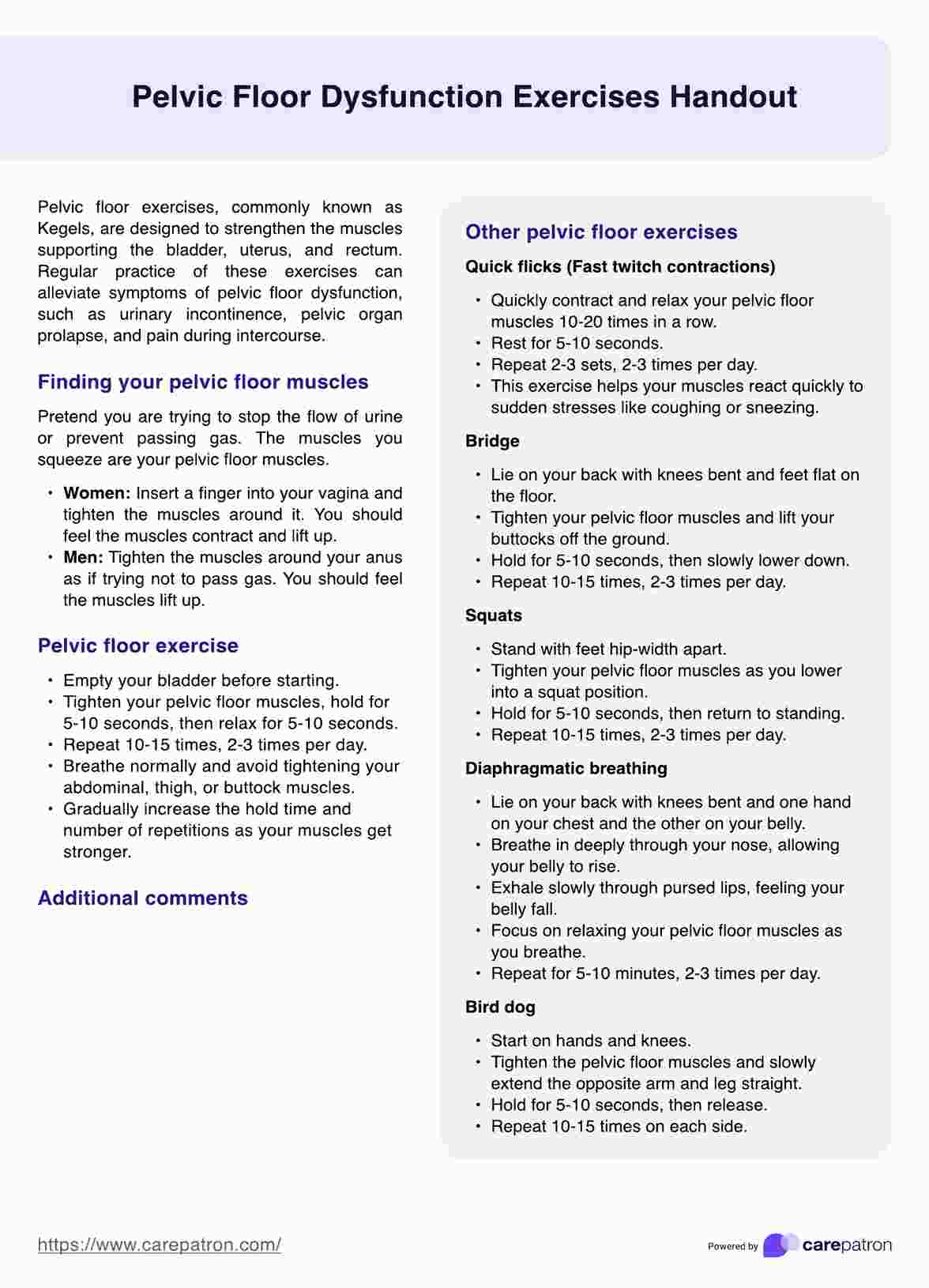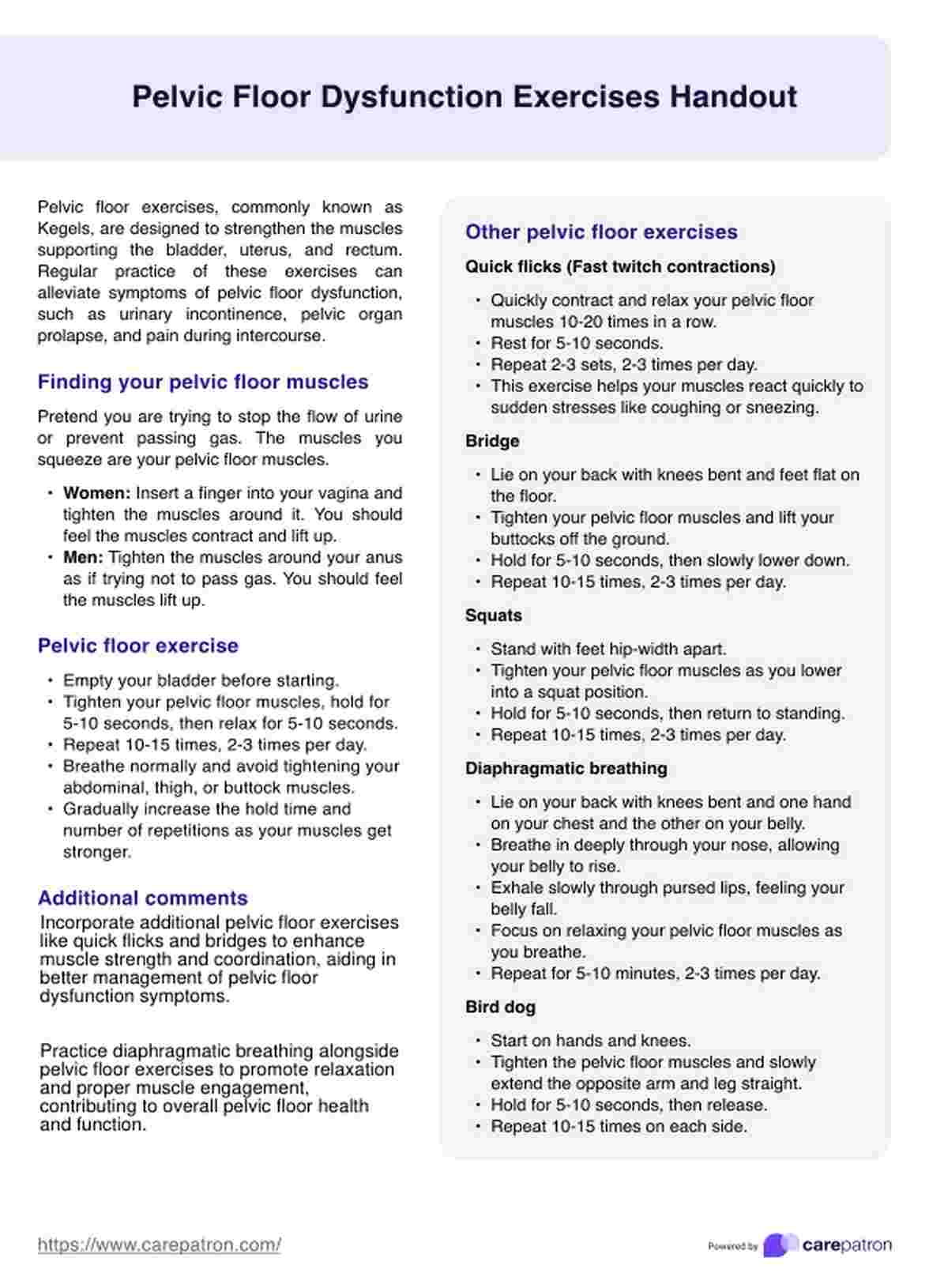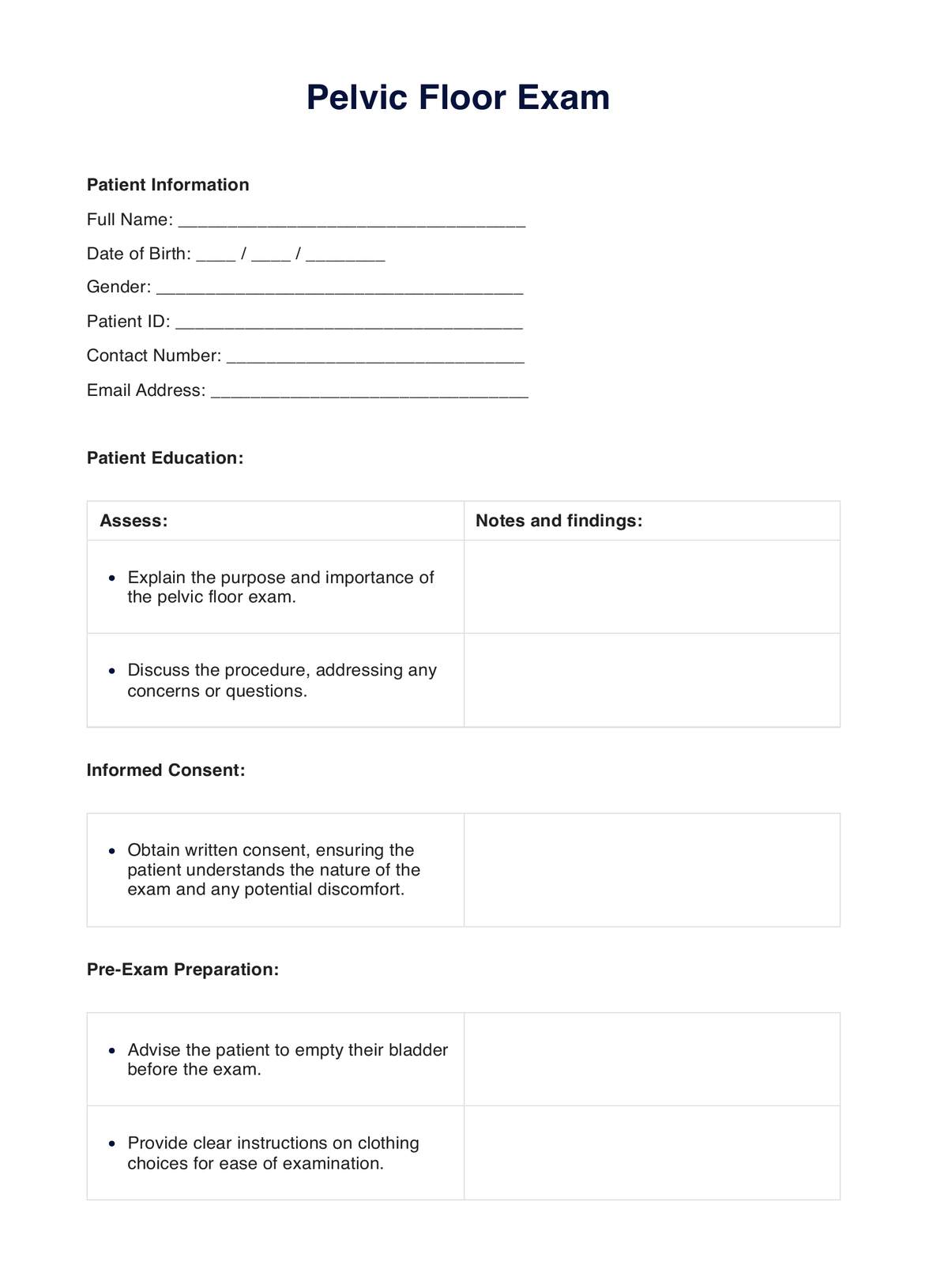Pelvic Floor Dysfunction Exercises Handout
Download our Pelvic Floor Dysfunction Exercises Handout and use this handy resource to help a patient treat Pelvic Floor Dysfunction.


What is pelvic floor dysfunction?
The pelvic floor is composed of multiple muscles that support the rectum in a sling-like manner. These muscles must coordinate their contractions and relaxations to effectively control bowel and bladder functions.
For activities such as urination, bowel movements, and sexual intercourse in women, the pelvic floor needs to relax. When these muscles are either too tense (high tone) or too relaxed (low tone), pelvic floor dysfunction happens, resulting in urinary incontinence, constipation, pain during intercourse, or pain in the lower back, pelvic region, genitals, or rectum.
The main causes of pelvic floor dysfunction include pregnancy, obesity, and menopause. Additionally, some women are genetically predisposed to this condition, being born with naturally weaker connective tissue and fascia.
Symptoms of pelvic floor dysfunction include urinary issues such as incontinence, difficulty starting urination, frequent urination, and painful urination; bowel problems like constipation, straining, incomplete evacuation, and fecal incontinence; pain in the pelvic region, lower back, during intercourse, and in the genitals or rectum; and other symptoms of pelvic health such as pelvic pressure, muscle spasms, and unexplained pelvic discomfort.
Pelvic Floor Dysfunction Exercises Handout Template
Pelvic Floor Dysfunction Exercises Handout Example
Importance of strengthening pelvic floor muscles
Strengthening the pelvic floor muscles through exercises offers several key benefits. Firstly, it improves bladder and bowel control by preventing urine leakage (incontinence) and accidental passing of gas or stool. Additionally, strong pelvic muscles reduce the risk of pelvic floor disorders such as pelvic organ prolapse which can feel like a bulge in the vagina or rectum.
These exercises also facilitate easier childbirth and postpartum recovery by aiding in delivery and reducing incontinence after giving birth. Furthermore, they enhance sexual function by increasing sexual sensation and orgasmic potential while reducing pain during intercourse.
Pelvic floor muscle exercises
Physical therapists can teach their patients a variety of exercises to strengthen weak pelvic floor muscles, including:
- Kegel exercises: These are the most well-known pelvic floor exercises. To perform them, contract the pelvic floor muscles as if trying to stop the urine flow. Hold for 5-10 seconds, then relax for 5-10 seconds. Repeat 10-15 times, 2-3 times per day. Physical therapists can help patients identify the correct muscles and ensure proper technique.
- Quick flicks: Also known as "quick contractions," involve rapidly contracting and relaxing the pelvic floor muscles. Contract quickly and strongly, then immediately relax. Perform 10-20 repetitions, 2-3 times per day. This exercise helps the pelvic floor muscles react promptly to sudden stresses like sneezing or coughing.
- Bridge: Lie on your back with your knees bent and feet flat. Tighten the pelvic floor and glute muscles and lift your hips. Hold for 5-10 seconds, then slowly lower back down. Repeat 10-15 times. This exercise works the pelvic floor muscles in coordination with the glutes and core.
- Squats: Stand with feet hip-width apart. Slowly bend your knees and lower into a squat, keeping your back straight and chest lifted. Focus on tightening the pelvic floor muscles while squatting. Hold for 5-10 seconds, then return to standing. Repeat 10-15 times. Squats help strengthen the pelvic floor muscles in a functional position.
- Diaphragmatic breathing: Lie on your back with knees bent and one hand on your chest and the other on your belly. Breathe in deeply through your nose, allowing your belly to rise. Exhale slowly through pursed lips, feeling your belly fall. Focus on relaxing your pelvic floor muscles as you breathe. Repeat for 5-10 minutes, 2-3 times per day.
- Bird dog: Start on hands and knees. Tighten the pelvic floor muscles and slowly extend the opposite arm and leg out straight. Hold for 5-10 seconds, then release. Repeat 10-15 times on each side. This exercise challenges pelvic floor strength while stabilizing the core and spine.
How to use our Pelvic Floor Dysfunction Exercises Handout
Here are some tips on how you can use our free Pelvic Floor Dysfunction Exercises Handout template effectively:
Introduction to the handout
Begin by explaining the purpose of the handout to your patient. Highlight that it provides a comprehensive guide to exercises aimed at strengthening the pelvic floor and core muscles and to alleviate symptoms of pelvic floor dysfunction.
Review the content
Walk through the handout with your patient. Make sure they understand each section, including the importance of pelvic floor exercises, identifying the pelvic floor muscles, the pelvic floor muscle training and the detailed instructions for each exercise.
Identifying the pelvic floor muscles
Demonstrate how to find and engage the pelvic floor muscles. Use the guidelines provided in the handout: For women, suggest for pelvic pain by inserting a finger into the vagina and tightening the muscles around it. For men, suggest tightening the muscles around the anus as if trying not to pass gas.
Explaining each exercise
Go over each exercise listed in the handout. Ensure that the patient understands the correct technique, repetitions, and frequency for each exercise.
How do professionals benefit from using this handout?
Enhanced patient education
The handout provides clear and detailed instructions for pelvic floor therapy or can aid during a pelvic floor exam, helping practitioners effectively educate patients about the importance of pelvic floor exercises and how to perform them correctly.
Consistency in care
By using a standardized handout, professionals ensure that all patients receive the same high-quality information and guidance, promoting consistency in treatment and care.
Time efficiency
The handout serves as a comprehensive resource that patients can refer to at home. It reduces the need for repeated in-depth explanations during appointments and allows practitioners to use their time more efficiently.
Improved patient compliance
The handout's step-by-step instructions make it easier for patients to follow their exercise routine, leading to better compliance and more effective treatment outcomes.
Commonly asked questions
Diagnosis typically involves a physical examination, patient history, and sometimes imaging tests or specialized tests like urodynamics to assess the function of the pelvic organs and floor muscles.
Yes, treatment options include physical therapy, pelvic floor exercises (Kegels), biofeedback, medications, and, in some cases, surgery.
Pelvic floor exercises, such as Kegels, involve pelvic floor function, including contracting and relaxing the pelvic floor muscles. Exercises strengthen your pelvic floor, which can improve symptoms of pelvic floor dysfunction like urinary incontinence and pelvic pain.








































































































